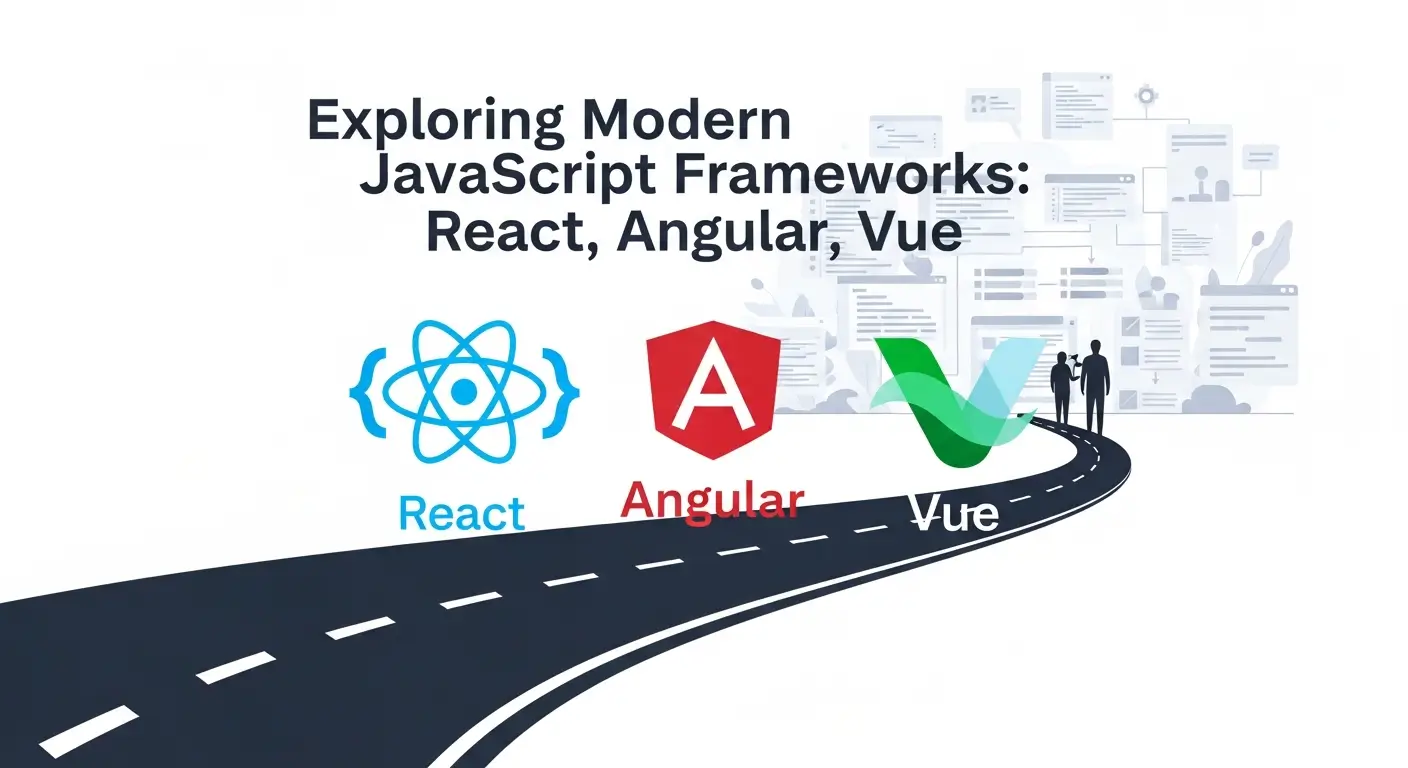In the rapidly evolving landscape of web development, choosing the right JavaScript framework can significantly impact the success and maintainability of your project. For developers and businesses alike, understanding the nuances of modern JavaScript frameworks is crucial. This comprehensive guide delves into the powerhouses of front-end development: React, Angular, and Vue.js, offering a detailed comparison to help you make an informed decision.
The Rise of JavaScript Frameworks: Why They Matter
Gone are the days of building complex web applications with just vanilla JavaScript. Modern JavaScript frameworks provide a structured, efficient, and scalable approach to developing interactive user interfaces. They abstract away much of the underlying DOM manipulation, offer component-based architectures, and streamline state management, leading to faster development cycles and more robust applications. As a result, mastering at least one of these frameworks has become a prerequisite for any aspiring front-end developer and a key factor in building high-performing web solutions.
React: The Declarative Library for Building User Interfaces
Born at Facebook, React is often described as a JavaScript library for building user interfaces, not a full-fledged framework. Its declarative nature and component-based architecture have made it incredibly popular, especially for single-page applications (SPAs) and mobile applications (React Native).
Key Features and Benefits of React:
- Component-Based Architecture: Everything in React is a component. This modular approach promotes reusability, making it easier to manage complex UIs and collaborate on large projects. Think of components as independent, self-contained building blocks for your application.
- Virtual DOM: React utilizes a virtual DOM, which is a lightweight copy of the actual DOM. When a component’s state changes, React first updates the virtual DOM, then efficiently calculates the differences (diffing algorithm), and finally updates only the necessary parts of the real DOM. This minimizes direct DOM manipulation, leading to significant performance improvements.
- Declarative Syntax (JSX): React uses JSX (JavaScript XML), an extension that allows you to write HTML-like code within your JavaScript. While it might seem unfamiliar at first, JSX makes component structure and rendering logic incredibly clear and intuitive.
- Unidirectional Data Flow: React enforces a unidirectional data flow (often combined with state management libraries like Redux or Context API), which makes debugging easier and applications more predictable. Data flows down from parent components to children, and actions flow up.
- Strong Community and Ecosystem: React boasts a massive and active community. This translates into abundant resources, tutorials, third-party libraries, and readily available support, making it easier to overcome development challenges.
- Flexibility: React’s library status means it gives developers more freedom in choosing other tools and libraries (e.g., for routing, state management, styling).
When to Choose React:
React is an excellent choice for:
- Large-scale applications with constantly changing data.
- SPAs and complex UIs requiring high interactivity.
- Projects where flexibility in technology stack is desired.
- Mobile application development (React Native).
For businesses seeking reactjs development services, leveraging this powerful library can result in highly performant and user-friendly applications.
Angular: The Comprehensive MVVM Framework
Developed and maintained by Google, Angular is a full-fledged, opinionated framework that offers a complete solution for building enterprise-grade web applications. It follows the Model-View-ViewModel (MVVM) architecture and provides a structured environment with a rich set of built-in features.
Key Features and Benefits of Angular:
- TypeScript by Default: Angular is built with TypeScript, a superset of JavaScript that adds static typing. This brings significant benefits, including improved code quality, better error detection during development, and enhanced maintainability, especially in large teams.
- Comprehensive Framework: Angular provides a complete ecosystem, including routing, state management, HTTP client, form handling, and more, right out of the box. This reduces the need to choose and integrate separate libraries.
- Two-Way Data Binding: Angular’s two-way data binding automatically synchronizes the model and the view. Changes in the view are reflected in the model, and vice-versa, simplifying data flow for many scenarios.
- Dependency Injection: Angular’s powerful dependency injection system promotes modularity and testability. It allows components and services to declare their dependencies, which Angular then provides, reducing boilerplate code.
- CLI (Command Line Interface): The Angular CLI is a robust tool that streamlines the development process. It allows developers to quickly generate components, services, modules, and even entire projects, as well as manage builds and testing.
- Material Design Integration: Angular has seamless integration with Angular Material, a UI component library that implements Google’s Material Design, enabling developers to build visually appealing and consistent applications.
When to Choose Angular:
Angular is particularly well-suited for:
- Large, complex enterprise-level applications.
- Projects requiring a highly structured and opinionated framework.
- Teams that prefer TypeScript for its type safety and scalability benefits.
- Applications needing a full-stack solution with built-in features.
For robust and scalable solutions, consider dedicated angularjs development services.
Vue.js: The Progressive and Approachable Framework
Vue.js, often referred to simply as Vue, is a progressive framework that is designed to be incrementally adoptable. Created by Evan You, it strikes a balance between React’s flexibility and Angular’s comprehensiveness, offering an approachable learning curve and excellent performance.
Key Features and Benefits of Vue.js:
- Approachable Learning Curve: Vue is renowned for its ease of learning. Its syntax is clean and intuitive, making it a great choice for developers new to modern JavaScript frameworks or those coming from jQuery.
- Progressive Adoption: You can use Vue for anything from a small interactive widget on an existing page to a full-blown single-page application. This flexibility makes it easy to integrate into existing projects without a complete rewrite.
- Component-Based Architecture: Like React, Vue leverages a component-based architecture, promoting reusability and maintainability. Single-File Components (SFCs) allow you to encapsulate HTML, CSS, and JavaScript for a component in a single .vue file.
- Reactivity System: Vue features a highly efficient and intuitive reactivity system. When data changes, Vue automatically tracks dependencies and updates only the necessary parts of the DOM, similar to React’s virtual DOM but often with less boilerplate.
- Flexibility and Ecosystem: Vue offers a good balance of guided structure and flexibility. Its official ecosystem includes powerful tools like Vue Router for routing and Pinia (or Vuex) for state management.
- Excellent Performance: Vue is lightweight and highly optimized for performance, often outperforming its counterparts in certain benchmarks.
When to Choose Vue.js:
Vue is an ideal choice for:
- Small to medium-sized projects that require rapid development.
- Developers looking for an easy-to-learn and highly productive framework.
- Integrating interactive elements into existing web applications.
- Projects where performance and lightweight footprint are critical.
For projects valuing flexibility and a gentle learning curve, vuejs development services can provide an agile and efficient solution.
Side-by-Side Comparison: React vs. Angular vs. Vue
| Feature | React | Angular | Vue.js |
| Type | Library for UI development | Full-fledged MVVM Framework | Progressive MVVM Framework |
| Learning Curve | Moderate (requires learning JSX) | Steep (opinionated, TypeScript) | Easy (intuitive syntax) |
| Language | JavaScript (with JSX) | TypeScript | JavaScript (with SFCs) |
| Data Binding | Unidirectional (often with Redux) | Two-way | Two-way (flexible) |
| Performance | High (Virtual DOM) | High (Ahead-of-Time compilation) | High (lightweight, optimized reactivity) |
| Community/Support | Very Large, active, and mature | Large, enterprise-focused | Growing rapidly, very supportive |
| Ecosystem | Flexible, extensive third-party | Comprehensive, built-in | Official, well-integrated |
| Best For | Complex SPAs, UI-heavy apps, mobile | Enterprise apps, large teams, structured | SPAs, smaller projects, progressive enhancement |
Choosing the Right Framework for Your Project
The “best” framework is subjective and depends heavily on your specific project requirements, team expertise, and long-term goals.
- For large-scale enterprise applicationsdemanding structure, scalability, and type safety, Angular often comes out on top. Its opinionated nature can be a boon for large teams needing consistency.
- For highly interactive user interfaceswhere flexibility and a vibrant ecosystem are paramount, React is an excellent choice. Its popularity ensures a wealth of resources and talent.
- For projects that prioritize ease of entry, flexibility, and rapid development, or for integrating into existing applications, Vue.js offers a compelling and highly performant solution.
It’s also worth considering the talent pool available. React developers are abundant, while Angular developers are often found in enterprise environments. Vue.js’s growing popularity means its talent pool is expanding rapidly.
The Future of Front-End Development
The landscape of JavaScript frameworks is constantly evolving. While React, Angular, and Vue continue to dominate, newer tools and advancements are always on the horizon. Staying updated with best practices, understanding the core principles of component-based development, and being open to learning new technologies will be key for sustained success in web development services.
Ready to Build Your Next Web Application?
Whether you’re embarking on a new project or looking to refactor an existing one, choosing the right JavaScript framework is a critical decision. Each framework brings unique strengths to the table, designed to empower developers to build robust, scalable, and engaging web experiences.
Still unsure which framework is right for you?Reach out to our team of expert developers for a personalized consultation and let us help you navigate the complexities of modern web development. Discover how we can help bring your vision to life with cutting-edge technology and unparalleled expertise!

